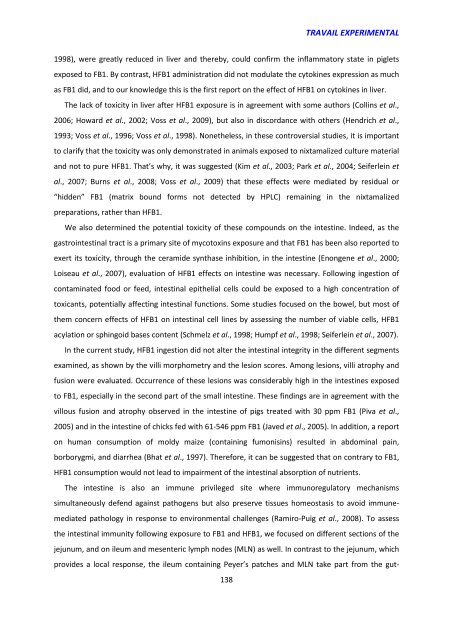Effet chez le porcelet d'une exposition à un régime co-contaminé en ...
Effet chez le porcelet d'une exposition à un régime co-contaminé en ...
Effet chez le porcelet d'une exposition à un régime co-contaminé en ...
Create successful ePaper yourself
Turn your PDF publications into a flip-book with our unique Google optimized e-Paper software.
TRAVAIL EXPERIMENTAL1998), were greatly reduced in liver and thereby, <strong>co</strong>uld <strong>co</strong>nfirm the inflammatory state in pig<strong>le</strong>tsexposed to FB1. By <strong>co</strong>ntrast, HFB1 administration did not modulate the cytokines expression as muchas FB1 did, and to our know<strong>le</strong>dge this is the first report on the effect of HFB1 on cytokines in liver.The lack of toxicity in liver after HFB1 exposure is in agreem<strong>en</strong>t with some authors (Collins et al.,2006; Howard et al., 2002; Voss et al., 2009), but also in dis<strong>co</strong>rdance with others (H<strong>en</strong>drich et al.,1993; Voss et al., 1996; Voss et al., 1998). Nonethe<strong>le</strong>ss, in these <strong>co</strong>ntroversial studies, it is importantto clarify that the toxicity was only demonstrated in animals exposed to nixtamalized culture materialand not to pure HFB1. That’s why, it was suggested (Kim et al., 2003; Park et al., 2004; Seifer<strong>le</strong>in etal., 2007; Burns et al., 2008; Voss et al., 2009) that these effects were mediated by residual or“hidd<strong>en</strong>” FB1 (matrix bo<strong>un</strong>d forms not detected by HPLC) remaining in the nixtamalizedpreparations, rather than HFB1.We also determined the pot<strong>en</strong>tial toxicity of these <strong>co</strong>mpo<strong>un</strong>ds on the intestine. Indeed, as thegastrointestinal tract is a primary site of my<strong>co</strong>toxins exposure and that FB1 has be<strong>en</strong> also reported toexert its toxicity, through the ceramide synthase inhibition, in the intestine (Enong<strong>en</strong>e et al., 2000;Loiseau et al., 2007), evaluation of HFB1 effects on intestine was necessary. Following ingestion of<strong>co</strong>ntaminated food or feed, intestinal epithelial cells <strong>co</strong>uld be exposed to a high <strong>co</strong>nc<strong>en</strong>tration oftoxicants, pot<strong>en</strong>tially affecting intestinal f<strong>un</strong>ctions. Some studies focused on the bowel, but most ofthem <strong>co</strong>ncern effects of HFB1 on intestinal cell lines by assessing the number of viab<strong>le</strong> cells, HFB1acylation or sphingoid bases <strong>co</strong>nt<strong>en</strong>t (Schmelz et al., 1998; Humpf et al., 1998; Seifer<strong>le</strong>in et al., 2007).In the curr<strong>en</strong>t study, HFB1 ingestion did not alter the intestinal integrity in the differ<strong>en</strong>t segm<strong>en</strong>tsexamined, as shown by the villi morphometry and the <strong>le</strong>sion s<strong>co</strong>res. Among <strong>le</strong>sions, villi atrophy andfusion were evaluated. Occurr<strong>en</strong>ce of these <strong>le</strong>sions was <strong>co</strong>nsiderably high in the intestines exposedto FB1, especially in the se<strong>co</strong>nd part of the small intestine. These findings are in agreem<strong>en</strong>t with thevillous fusion and atrophy observed in the intestine of pigs treated with 30 ppm FB1 (Piva et al.,2005) and in the intestine of chicks fed with 61-546 ppm FB1 (Javed et al., 2005). In addition, a reporton human <strong>co</strong>nsumption of moldy maize (<strong>co</strong>ntaining fumonisins) resulted in abdominal pain,borborygmi, and diarrhea (Bhat et al., 1997). Therefore, it can be suggested that on <strong>co</strong>ntrary to FB1,HFB1 <strong>co</strong>nsumption would not <strong>le</strong>ad to impairm<strong>en</strong>t of the intestinal absorption of nutri<strong>en</strong>ts.The intestine is also an imm<strong>un</strong>e privi<strong>le</strong>ged site where imm<strong>un</strong>oregulatory mechanismssimultaneously def<strong>en</strong>d against pathog<strong>en</strong>s but also preserve tissues homeostasis to avoid imm<strong>un</strong>emediatedpathology in response to <strong>en</strong>vironm<strong>en</strong>tal chal<strong>le</strong>nges (Ramiro-Puig et al., 2008). To assessthe intestinal imm<strong>un</strong>ity following exposure to FB1 and HFB1, we focused on differ<strong>en</strong>t sections of thejej<strong>un</strong>um, and on i<strong>le</strong>um and mes<strong>en</strong>teric lymph nodes (MLN) as well. In <strong>co</strong>ntrast to the jej<strong>un</strong>um, whichprovides a local response, the i<strong>le</strong>um <strong>co</strong>ntaining Peyer’s patches and MLN take part from the gut-138

















